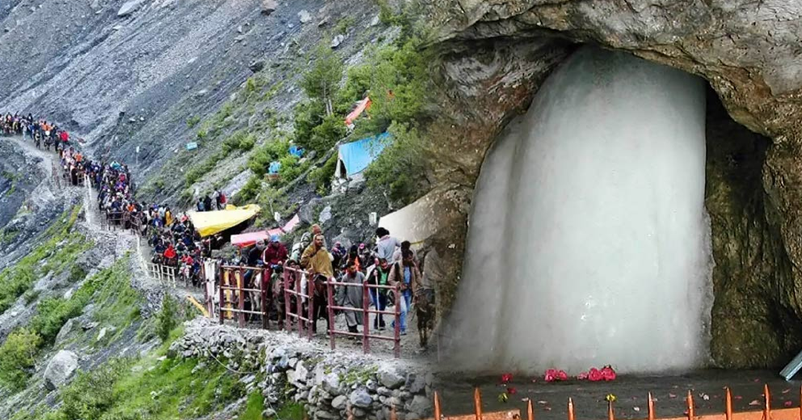
The Amarnath Yatra is a significant pilgrimage for Hindus, with devotees making the arduous trek to the Amarnath Cave in Jammu and Kashmir to seek the blessings of Lord Shiva. This detailed travel guide will provide you with all the essential information and tips to ensure a safe and fulfilling journey to this sacred site. From the best time to visit and the trekking routes to accommodation options and important rituals, this guide aims to equip you with everything you need to know for a successful Amarnath Yatra experience. So, gear up for an unforgettable spiritual journey as we delve into the intricacies of the Amarnath Yatra.
The Amarnath Holy Shrine: History, Location, and Religious Importance
The Amarnath Cave, located in Jammu and Kashmir, is considered one of the holiest shrines in Hinduism and holds great religious significance. According to Hindu mythology, it is believed to be the place where Lord Shiva explained the secret of immortality to his wife Parvati. The shrine houses a naturally formed ice Shiva Lingam, which is revered by millions of devotees who visit the cave during the annual pilgrimage.
The cave is situated at an altitude of approximately 3,888 meters and is surrounded by snowy peaks, adding to the spiritual aura of the site. The trek to the Amarnath Cave is not only a physical journey but also a deeply spiritual one, as devotees endure the challenging terrain and harsh weather conditions to seek the blessings of Lord Shiva.
The Amarnath Yatra holds immense religious significance for Hindus, as it is believed that a darshan (sight) of the ice Shiva Lingam in the cave is a way to attain spiritual liberation. Pilgrims undertake this arduous journey with unwavering faith and devotion, embracing the physical and mental challenges as part of their spiritual quest.
The journey to the Amarnath Cave is a reminder of the profound connection between mythology, spirituality, and the awe-inspiring natural landscape of the region. It offers pilgrims a unique opportunity to immerse themselves in the legends and traditions of Hinduism while experiencing the breathtaking beauty of the Himalayas.
As you prepare for your Amarnath Yatra, may the rich history, sacred location, and religious importance inspire and guide you on your spiritual expedition to the revered Amarnath holy shrine.
Best Time to Visit
The best time to undertake the Amarnath Yatra is during the months of July and August when the shrine is open to pilgrims. The Yatra dates are determined by the Hindu calendar and usually coincide with the auspicious day of Guru Purnima. During this time, the weather is relatively stable, and the trekking routes are accessible.
Trekking Routes
There are two main routes for the Amarnath Yatra: the traditional Pahalgam route and the shorter Baltal route. The Pahalgam route is longer but offers stunning views of the Himalayas, while the Baltal route is known for its steep ascent but is relatively shorter in distance.
Accommodation Options
During the Yatra, various accommodation options are available for pilgrims, including government-organized tents and private lodges. It’s essential to book your accommodation in advance, especially during peak season, to ensure a comfortable stay during the pilgrimage.
Registration for Amarnath yatra
Participating in the traditional rituals of the Amarnath Yatra is an integral part of the experience. The journey includes performing puja at Chandanwari, Sheshnag, and Panchtarni before reaching the Amarnath Cave. It’s important to familiarize yourself with these rituals and their significance before embarking on the pilgrimage.
To register for the Amarnath Yatra, pilgrims are required to apply through the official registration process organized by the Shri Amarnath Shrine Board. The registration process typically opens a few months before the Yatra commences, and it is crucial to keep an eye on the official website of SASB for updates and announcements regarding the registration dates and procedures. Upon successful registration, pilgrims receive a Yatra Permit which grants them access to the pilgrimage route.
To ensure a smooth and hassle-free registration process, it is advisable to have all the necessary documents and details ready, including personal identification documents, contact information, and travel plans. Additionally, staying informed about any updates or changes to the registration process is essential to avoid any last-minute complications. By following the official guidelines and completing the registration process in a timely manner, pilgrims can secure their participation in the Amarnath Yatra and be well-prepared for this spiritually enriching journey.
